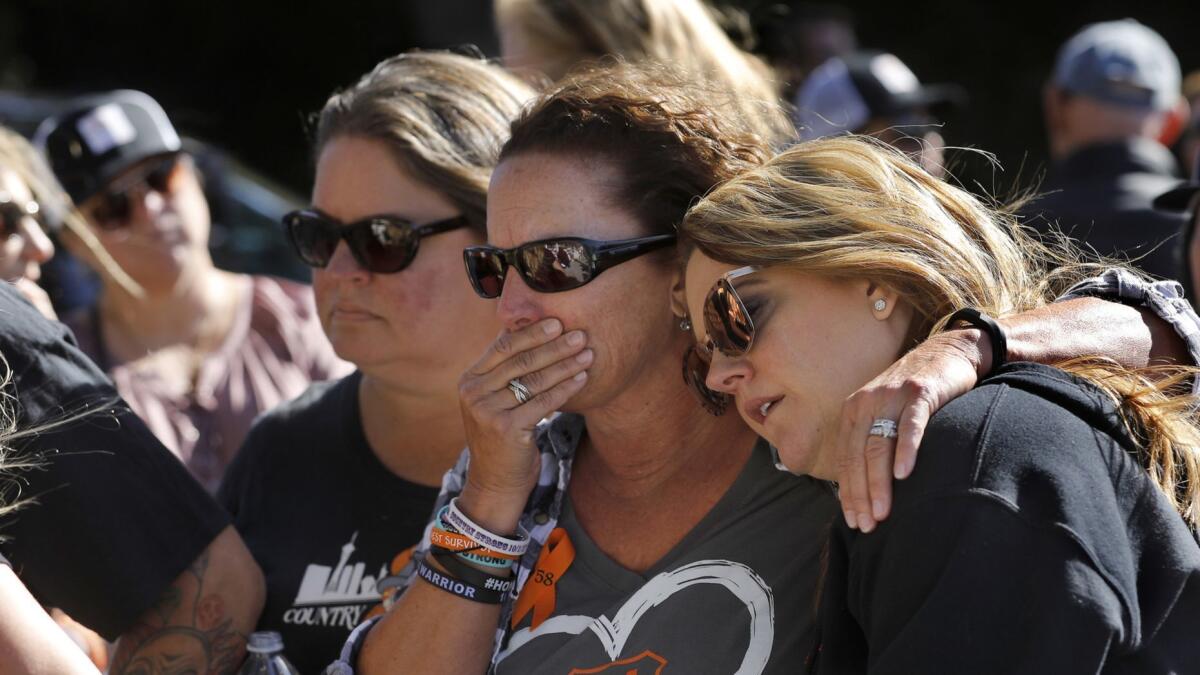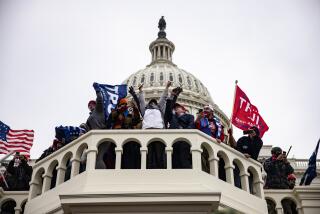Column: Will the election and the Thousand Oaks killings finally move the needle on gun control?

- Share via
It’s barely worth mentioning anymore that the public and political responses to mass shootings trace a dismal pattern: Public shock, grief and mourning; “thoughts and prayers” from politicians beholden to the National Rifle Assn.; calls to avoid “politicizing” the tragedy; and finally, no action from lawmakers in Washington.
There are signs that this pattern is shifting—partially in the wake of the midterm elections Nov. 6, and possibly in the aftermath of the Thousand Oaks massacre of Wednesday, when a troubled veteran killed 12, and the Parkland, Fla., shootings of Feb. 14, which took 17 lives.
The elections brought 17 Democrats who campaigned on stricter gun laws to the House for the first time. At least 23 candidates rated by the NRA to have strong pro-gun rights records lost. The incoming Congress will seat at least 171 members with low NRA ratings of 0-13%, as against 144 with ratings of 87-100%, according to number crunching by CNBC.
Elements of the story in Thousand Oaks are all too familiar.
— Garen Wintemute, UC Davis
The Thousand Oaks killings have already focused a spotlight on California regulations designed to limit access to lethal weapons, especially by people who may be predisposed to violence. These include restrictions on large-capacity ammo magazines and a waiting period allowing for restraining orders to block gun purchases by troubled potential shooters.
Ian David Long was one such individual. As my colleagues Ruben Vives, Matt Hamilton and Eric Sondheimer reported the day after the shooting, Long’s behavior “alarmed roommates and neighbors, and drew police to his home,” though he was never taken into custody for mental health treatment. A large-capacity magazine apparently was part of the arsenal he brought to the Borderline Bar and Grill on Wednesday. Long was found dead at the scene, presumably by his own hand.
“Elements of the story in Thousand Oaks are all too familiar,” Garen Wintemute, head of the Violence Prevention Research Program at UC Davis, wrote Nov. 8 in the Sacramento Bee. “He was known to his neighbors and law enforcement to be deeply troubled. He was not prohibited from purchasing or possessing firearms, though he had been evaluated earlier this year for the possibility of severe mental illness. He had a high-capacity ammunition magazine.”
California requires a 10-day waiting period on firearm purchases, during which background checks can establish whether a buyer is a member of a prohibited class of purchasers—felons, those with a history of violent crime, substance abuse or severe mental illness.
The waiting period also allows family members and law enforcement officials to seek restraining orders blocking purchases by those not otherwise prohibited.
Wintemute says he’s aware of two cases, one in Northern California and another in Southern California, in which individuals who had made credible threats but were not otherwise prohibited persons were blocked during the waiting period from completing firearms purchases. “In both cases, the threats came to the attention of law enforcement during the waiting period,” he told me. “They petitioned for and received gun violence restraining orders, and blocked the transfer of the firearms.”
California’s ban on the possession of high-capacity magazines—those holding more than 10 rounds—might also have limited Long’s carnage. But the rule, enacted by Proposition 63 in 2016, was blocked last year by federal Judge Roger T. Benitez of San Diego, ruling in a case brought by five California residents and an affiliate of the NRA. His preliminary injunction was upheld in July by a 2-1 majority on the U.S. 9th Circuit Court of Appeals. The initiative expanded a prior ban on the purchase or importation of a high-capacity magazine to cover possession; it required owners to transfer the magazine out of state, sell it to a licensed dealer, or surrender it to law enforcement.
Benitez’s ruling that the ban on high-capacity magazines violated the 2nd Amendment made him an outlier on the federal bench, according to Hannah Shearer, 2nd Amendment litigation director at the Giffords Law Center to Prevent Gun Violence. “He’s the only federal judge in the country to reach that conclusion,” she told me. Benitez’s ruling on whether to make his injunction permanent is expected within weeks, with a trial to follow next year if he does so and is again upheld on appeal.
A George W. Bush appointee, Benitez hasn’t previously ruled on a gun-rights case, Shearer says. But his ruling on this one bristled with extreme language. Referring to the effective date of Proposition 63, he wrote: “On July 1, 2017, any previously law-abiding person in California who still possesses a firearm magazine capable of holding more than 10 rounds will begin their new life of crime.”
Benitez painted a febrile picture of families needing the magazines because they live “far from timely help by local law enforcement agencies and who must be self-reliant for their own defense,” or who “should the need ever arise, may be called upon to form a militia for the protection of the state from either foreign or domestic enemies.”
He dismissed evidence of the role of the banned magazine in mass shootings. Of 92 mass shootings between 2009 and 2013 listed in a survey by Mayors Against Illegal Guns, an organization formed by former New York Mayor Michael R. Bloomberg, “only two occurred in California and involved the use of illegal magazines,” he wrote.
These were a June 2013 shooting rampage in Santa Monica and a March 2009 attack in Oakland. Those shootings cost the lives of nine persons, including four police officers slain in the Oakland attack. Benitez said he doubted whether the magazine ban would have “provided additional protection from gun violence...or prevented the crime.”
It’s true that high-capacity magazines are seldom, if ever, the governing factor in the toll from mass shootings. It’s also true that background checks are imperfect—factors warranting prohibitions aren’t always seamlessly reported to databases, and families may not seek restraining orders against relatives even when they know of dangerous behavior.
But as Wintemute observed in September in the New England Journal of Medicine, “The argument that a policy will not function perfectly should not prevent it from being enacted.”
Opinion polls indicate that the public is overwhelmingly in favor of waiting periods for all firearms purchases, and favor universal background checks almost unanimously—97%, according to a Quinnipiac University poll in February.
The midterm election results suggest that the public has lost patience with the unfettered gun ownership promoted by the NRA in statements like the one issued by the California Rifle & Pistol Assn., the NRA affiliate that brought the legal challenge to Proposition 63, after Thousand Oaks. “The vocal and well-heeled advocates of banning gun ownership,” the group stated, “will now orchestrate the narrative to portray this tragedy as another reason to drastically restrict the right to self-defense, or to ban certain guns, or ban certain gun parts, or ban standard capacity magazines, or ban gun shows, or ban gun stores, or ban gun advertising, or ban whatever else they can think of.”
Another indication is the firestorm the NRA sustained last week after a tweet mocking the American College of Physicians for calling for the treatment of gun violence as a public health issue.
“Someone should tell self-important anti-gun doctors to stay in their lane,” the NRA tweeted. Since then, Twitter has been inundated with responses from doctors detailing the devastation they’ve witnessed in emergency rooms when treating gunshot injuries. The tide may be turning. “Plans are underway,” Wintemute says, “to seize the momentum and turn this into a change in the practice of medicine.” That’s a start, but the practice of U.S. politics will have to change too.
Keep up to date with Michael Hiltzik. Follow @hiltzikm on Twitter, see his Facebook page, or email michael.hiltzik@latimes.com.
Return to Michael Hiltzik’s blog.
More to Read
Get the L.A. Times Politics newsletter
Deeply reported insights into legislation, politics and policy from Sacramento, Washington and beyond. In your inbox twice per week.
You may occasionally receive promotional content from the Los Angeles Times.











